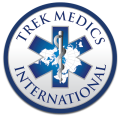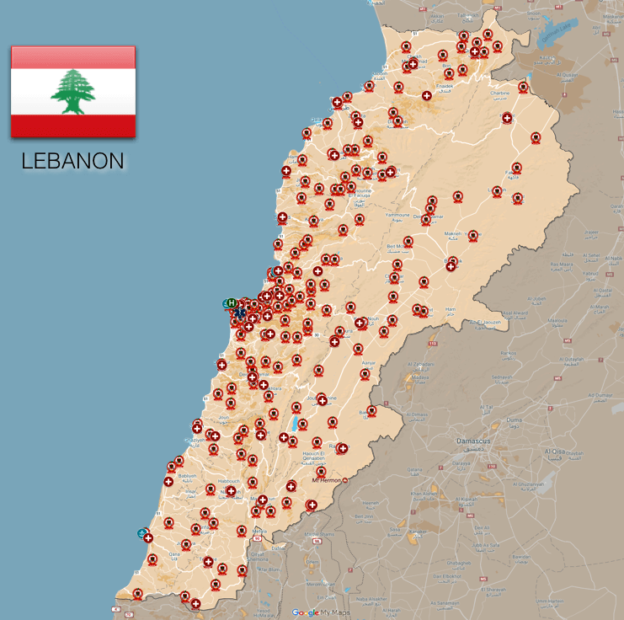AT-A-GLANCE
DIAL 140 or 125 TO CALL AN AMBULANCE IN LEBANON
Lebanon’s EMS system is primarily volunteer-based, split between the the Lebanese Red Cross and Civild Defense. While highly-committed and with a growing presence across the country, Lebanon emergency services are uncoordinated and can be unreliable. “The development of a comprehensive national emergency system remains an important and arduous task requiring the resolution of a set of complex problems on several levels” (Bayram, 2007) but “the existing structure of the EMS system in Lebanon is fragmented with little evidence of partnership among different stakeholders.” (El Sayed, 2013)
HOW CAN I CALL AN AMBULANCE IN LEBANON?
- Dial 140 for Lebanese Red Cross
- Dial 125 for Civil Defense
- Dial 175 for fire department
You may also want to save the numbers listed in the above map to connect directly with the Red Cross and/or Civil Defense stations nearest you. In Lebanon, there is no centralized dispatch system and the locals often call the direct number for each station. These numbers are included in the map at the top of the page. Numbers labeled with an “M” and start with 70 are mobile phone numbers; those labeled “T” and starting with a 0 are direct telephone lines to the station.
Original links are here (in Arabic):
- Red Cross Lebanon stations
- Civil Defense Lebanon stations
According to the Lebanese Red Cross (LRC) webpage:
“Any person who suffers an accident (work, car, ski, home …etc) can dial 140 toll free from any phone (regular or mobile) and from any region in Lebanon. The first aid teams will immediately answer his/her call.”
However it should be noted that while you may be able to call toll-free emergency numbers from across Lebanon, that doesn’t ensure that services will be prompt or available – or that you’ll be connected to the right call center. As of 2016, only 32 of LRC’s 46 stations were incorporated into their dispatch system. (Srour, 2016) In Southern Lebanon, reports estimated that up to 80% of the local population had not memorized the three-digit emergency numbers utilized by the respective prehospital providers (El Sayed, 2013). Very often the public will instead call directly to the local station, bypassing the nearest call center.
The reasons for this reliance on private transportation include delays in access – both in getting the ambulance to the patient, and in getting the patient to the hospital. In both cases traffic congestion is a major problem. According to 2016 call data, in 38% of cancelled calls, “the callers reported that the reason for cancellation was transport of the patient in a civilian car,” indicating a potential unwillingness of callers to wait. Traffic congestion during the day is also a problem in transporting patients to the hospital, with transport times “being nearly 50% higher during the day as compared to the night in Beirut” (Srour, 2016).
A third problem is redundancy of emergency services; despite often having a presence in the same cities, the Red Cross and Civil Defense do not coordinate communications. “Because of the absence of a single emergency access number for EMS and a unified dispatch center that coordinates EMS activities, the EMS system in Lebanon suffers from time delays in EMS responses and frequent redundancy of services with multiple ambulances from different agencies responding to the same scene” (El Sayed, 2013).
Other than the Red Cross (140), Civil Defense (125) and Police (112), there are few private ambulance providers in Lebanon, much less with information available on the internet:
Ground Ambulance in Lebanon
- PTS Ambulance (Bisco): +961 1 388688
Air Ambulance in Lebanon
Call 125 in disasters for the Civil Defense.
The Civil Defense is tasked with responding to and mitigating the impacts of natural and man-made disasters. However, as part of the fire department, they also respond to daily emergencies and have ambulances to transport. Similarly, the Red Cross is tasked with prehospital emergency care and transport, but will also participate in disaster response operations.
Yes, but there’s no national curriculum or training standards, leaving the different prehospital agencies to oversee their own training and testing standards. The Lebanese Red Cross offers basic life support (BLS) training courses of between 90-120 hours, while only some of the Civil Defense will undergo BLS training.
In 2009, the Lebanese Red Cross had 253 ambulances in 44 stations and the Civil Defense had 120 ambulances between 210 stations (El Sayed, 2013),
Very few private ambulances are used for prehospital emergency care; the majority are preserved for inter-facility transfers and mass-casualty incidents. Some private ambulance companies exist, but the majority of critical patients are transported via private vehicle to the hospital. (Bayram, 2007)
When ambulances are used to transport patients, they rarely provide advanced notification to receiving hospitals and, consequently, hospitals rarely inform ambulances of bed availability.
Emergency medicine is recognized as a medical specialty in Lebanon. However, unless you are in Beirut, and specifically headed to the American University of Beirut Medical Center (AUBMC), it is unlikely you will be transported to a hospital with trained emergency physicians. Furthermore, there is no current categorization of hospitals as emergency or trauma facilities.
“Neither the Lebanese Red Cross nor the Civil Defense bill for services.” (El Sayed, 2013)
ADDITIONAL INFO
Common Emergencies in Lebanon
- Road traffic injuries
- Security threats
Recommended Vaccinations for Lebanon
According to the US Centers for Disease Control and Prevention (CDC), different groups of travelers will require different vaccinations for travel in Morocco:
- All Travelers:
- Measles-mumps-rubella (MMR) vaccine
- Diphtheria-tetanus-pertussis vaccine
- Varicella (chickenpox) vaccine
- Polio vaccine
- Your yearly flu shot
- Most Travelers:
- Hepatitis A
- Typhoid
- Some Travelers:
- Hepatitis B
- Rabies
Read more about travel in Lebanon at the CDC website: https://wwwnc.cdc.gov/travel/destinations/traveler/none/lebanon/ (Last accessed: Aug. 7, 2017)
1965 – Lebanese Red Cross is mandated by Lebanese Ministry of Public Health to provide prehospital emergency care and transport
1974 – The Civil Defense is created within the Lebanese Fire Department and charged “to mitigate personal and property damages or losses resulting from wars or natural disasters, and is charged with urban search and rescue missions” (El Sayed, 2013)
2012 – US National Association of Emergency Medical Technicians (NAMET) awards Lebanese Red Cross grant to train some prehospital providers in Prehospital Trauma Life Support (PHTLS) course.
The Ministry of Public Health has given a mandate to the Lebanese Red Cross to provide prehospital emergency and transport across Lebanon. yet there remains an “absence of a lead agency that is statutorily charged with EMS oversight, planning, system assessment, policy development, and regulation” (El Sayed, 2013) resulting in different response agencies reporting to different government authorities and being held to different (if any) standards.
- Bayram JD: “Emergency medicine in Lebanon: Overview and prospects.” The Journal of Emergency Medicine 2007;32(2):217-22.
- El Sayed MJ et al: “Prehospital Emergency Medical Services in Lebanon: Overview and Prospects.” Prehospital and Disaster Medicine 2013;28(2):163-165.
- El Sayed MJ et al: “Emergency Medical Services Utilization in EMS Priority Conditions in Beirut, Lebanon.” Prehospital and Disaster Medicine 2016;31(6):621-7.
- Srour FJ, Jabr N: “Pre-Hospital Care Metrics as Reflected in Lebanese Red Cross Ambulance Response Data, Fourth Quarter, 2016.” Lebanese American University; Beirut, Lebanon. Available at: https://papers.ssrn.com/sol3/papers.cfm?abstract_id=2915386
SCOREBOARD
% of Seriously Injured Transported by Ambulance in Lebanon, 2013
[Source: 2013 Global Status Report on Road Safety, WHO]
% of Patients with Priority Conditions Presenting at Hospital by Ambulance
[Our estimate based on current expansion of official 911 system vs. total population]
ROAD TRAFFIC INJURY DEATHS
(PER 100,000 POPULATION)
[Source: 2015 Global Status Report on Road Safety, WHO]
REPORTED HOMICIDES
(PER 100,000 POPULATION)
[Source: 2014 Global Status Report on Violence Prevention, WHO-UNDP]
OFFICIAL TWITTER FEEDS
To read translated versions of Tweets in foreign languages, click on the feed to open it in the Twitter mobile app or webpage.
LEBANESE RED CROSS
CIVIL DEFENSE LEBANON




